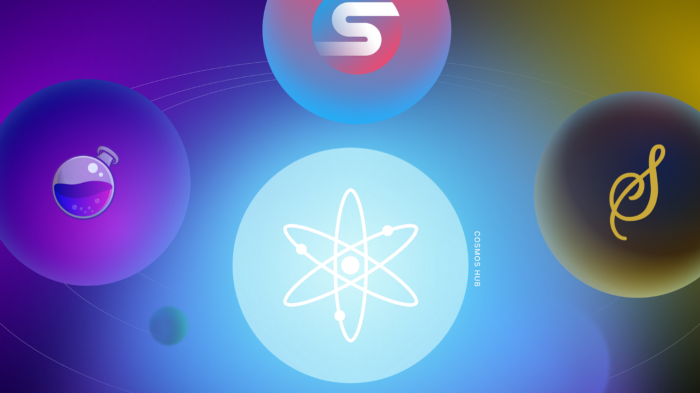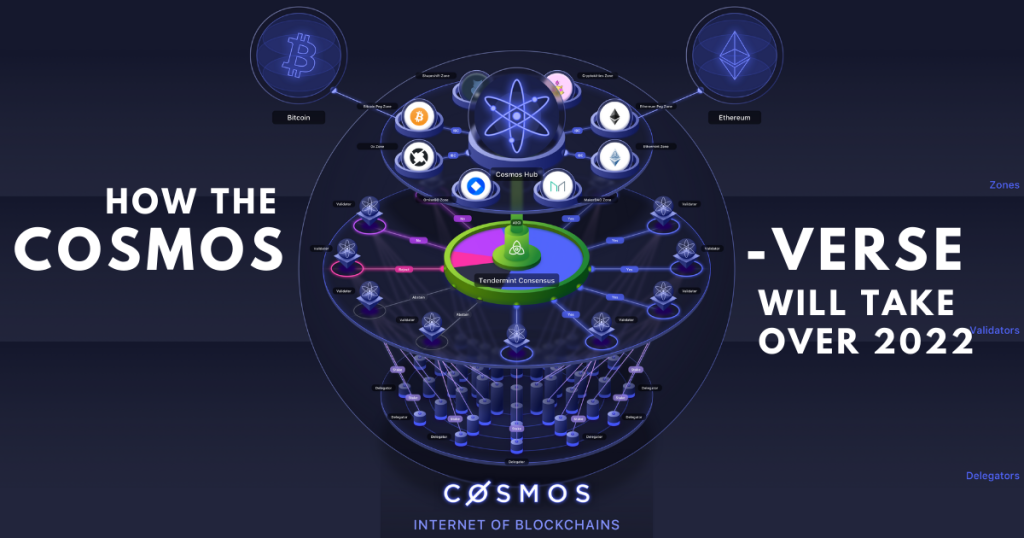What is Cosmos?
Cosmos was founded in 2014 by developers Jae Kwon and Ethan Buchman, with the goal was to create a “universe of systems” by facilitating blockchain interoperability — the ability for multiple blockchains to communicate and connect.
Currently, most cryptocurrencies functions in a smart and independent manner but fall shorts collectively. However, this race to interoperability will unlock the full potential in cryptocurrency’s network value by connecting various blockchains.
(Also Read: An Introduction To The Cosmos Ecosystem And Its ATOM Token)
Cosmos is one project which does that. They aim to solve three of the hardest blockchain problems of Scalability, Usability and Interoperability.
Scalability with Tendermint BFT
Tendermint BFT is a byzantine fault tolerant consensus engine that is considered the most secure and scalable blockchain to power the Cosmos proof of stake concept.
This would enable Cosmos to handle up to 10,000 transactions per section regardless of one third of validator nodes being offline.
Cosmos SDK solving for usability
Cosmos software development kit (SDK) is a framework for building application-specific blockchains.
In the Cosmos ecosystem, each application will retain sovereignty in its own blockchain as opposed to Ethereum, where applications are built following the rules of the host.

IBC protocol fixes Interoperability

Interblockchain Communication (IBC) is a communicative protocol for one blockchain to communicate with another. Cosmos fixes the issue on interoperability to allow various blockchain economies to be able to transfer assets between one another.
The “shopping mall” analogy

In simpler terms, the Cosmos ecosystem works like a huge shopping mall built by the Cosmos team. In this specific shopping mall, stores would be able to set up their shop for free and enjoy all the benefits from the customers entering the mall.
In the Cosmos section of the mall, where the Cosmos Hub resides, they use the native token $ATOM as currency. However, the other shops in the mall would be able to very own currency as without being forced to engage in Cosmos’s native $ATOM currency.
This environment Cosmos built creates a super flexible platform that gives blockchain protocols the freedom set up shop and above all, to share the users who flow through the entire ecosystem. Notable shops in the ecosystem include, $BTC, $ETH and $LUNA.
The current utility of ATOM token
ATOM is the native token for Cosmos and mainly has 3 use cases, (1) A spam prevention mechanism, (2) as staking token where ATOM can be bonded for rewards as economic safety for the Cosmos Hub, (3) a governance token where ATOM holders govern the Cosmos Hub by voting on proposals.
However, these use cases will not compare to the potential of what ATOM could reach if it becomes the main currency used by every store in the entire shopping mall/Cosmos Ecosystem. That is the shift in narrative for Cosmos in 2022.
Cosmos has evolved from a simple project whose aim is to connect various blockchains to a token with vast utilities. The new roadmap for Cosmos will make the token much more valuable in utility within its ecosystem and beyond. They achieve this by offering these businesses in the shopping mall enticing add on services to strength the core of their business. These services include
1. Staking in the Cosmos Hub
Staking in the Cosmos hub would mean ATOM tokens will be locked up as a digital asset to provide economic security for the blockchain. Furthermore, ATOM is currently providing 9.7% in APY rewards when stakers lock up their ATOM for staking.
2. Governance in the Cosmos Hub
Staking ATOM would also grant rights to vote on various proposals and potentially making future decisions of the network. This ensures that those who are participating in governance will be crucial in ensuring democratic governance of the ATOM token.
3. Stakedrops
Stakedrop is the token distribution mechanism that allows token holders to gain exposure to new tokens from the new chain. The new chains which are built on the cosmos SDK have the incentive to stakedrop ATOM holders as they are also likely to stake tokens dropped to them.
This will provide stability to the new chain as well as to increase its liquidity pool and user base. One recent example include Osmosis stakedropping ATOM holders with OSMO token after onboarding the cosmos SDK.
Cosmos function in the very near future
1. Onboard the Gravity DEX
Launched in May 2021, the gravity DEX which are fuelled by ATOM tokens made transactions easier and seamless for trade across different blockchains on the cosmos hub.
This opens up more transaction for the ATOM token, increasing its utility. Furthermore, transactions rewards will be shared between validators and delegators of ATOM which can also be processed by many other tokens in the ecosystem.
2. Gravity Bridge to Ethereum and beyond

The gravity bridge is an open and interoperable bridge between Ethereum and the cosmos hub. This opens the activity gates for cosmos as Ethereum has the largest ecosystem in the cryptocurrency world. Above all, enabling substantial liquidity and value to flow into the cosmos hub.
As ATOM tokens are used to secure the Cosmos hub, the increase in traffic in the hub provides validators and delegators more staking rewards which encourages the accumulation and staking of ATOM.
2022 and beyond for Cosmos
1. Interchain security solves composability
Interchain security will boost ATOM’s utility. Interchain security allows a blockchain to securely control an account on another blockchain using IBC. This would solve the composability within the Cosmos ecosystem without reducing zone sovereignty.
New chains will benefit from the robust validator security to get their tokens to cosmos community members in early stages. At the same time, Cosmos hub stakers would get early access to innovative project increasing the utility of ATOM.
Better yet, the completion of Interchain security will allow validators and delegators to earn staking rewards on multiple chains and tokens simultaneously just by staking ATOM on the hub.
2. Liquid Staking for ATOM holders

Version 1 of Liquid staking allows ATOM holders to send transactions that immediately convert their bonded ATOM into transferable representations to be used in liquidity pools. This opens up the realm of DeFi possibilities allowing holders to maximize their ATOM which earning staking rewards.
However, fluid tokens in version 1 are bonded to the validators where delegators stakes their ATOM token with maximizes staking rewards but poses restriction in its design. 2022 would see the rise of version 2 of liquid staking for cosmos with Lido, a liquid staking solution on Ethereum, to create smart contracts needed to engine away restrictions for the feature.
Cosmos hubs will directly be at the core of interchain, with its increase usability as a ‘true port city‘ in the cosmos ecosystem.
3. DeFi will skyrocket for Cosmos

With more fluidity in IBC connections, the ability to manage complex transactions across blockchain accounts, Cosmos DeFi is one to watch in the new year.
Staking with auto compounding rewards to maximize reward generation and the implementation of cross-chain DEX will deliver cosmos to be more lucrative in the DeFi space.
Osmosis will release their version of liquid staking, superfluid staking, on the cosmos hub. In summary, this allows OSMO holders to use their tokens for staking and liquidity providing at the same time while ensuring governance service the interest of liquidity providers. More on Superfluid staking by Osmosis co-founder, Sunny Aggarwal above.
I will be tracking this closely to see where superfluid staking of Osmosis and the IBC system of the cosmos ecosystem would take off. If executed right, this could revolutionize the norm of current DeFi protocols in the cryptocurrency market.
4. NFTs will be picture perfect
Beyond the rapid growing DeFi sector, 2021 has been such a year for NFTs, the explosion of digital art, collectibles and digital proof ownership. The Comsos ecosystem arise many projects to lay foundations of their launch in the coming year.
Stargaze is a decentralize community and network for NFTs built on the cosmos chain and running on its tendermint consensus engine. Their goal is to be the opensea of Cosmos except governed by the community via protocol DAO. Stargaze forms the foundation of cosmos entry into the NFT community.

The Secret Network also has its part to play in this space with cosmos for 2022. Their mainnet launch in November will support Secret NFTs with native privacy controls for ownership through the application Stashh.
Is $ATOM a good Investment now?
The Cosmos project aims to solve 3 of the hardest blockchain problems of Scalability, Usability and Interoperability. They aim to be the centrepiece of the cryptocurrency space by being a true city port, engaging in projects to allow various blockchains to not only communicate but to co-existing in one another’s function.
Cosmos’s fundamental purpose thrives with partnerships with projects utilizing their blockchain. 2022 will the year they for them to increase the value of its entire ecosystem along with their participants with added utility to their ATOM token of interchain security, liquid staking and providing an NFT space.
By doing so, the possibility of cosmos opening up a brand new space and providing new value for users through the gravity bridge with Ethereum, Superfliud staking with Osmosis as well as delving in the world of NFTs with Stargaze and SCRT Network will be out of this world.
(Not Financial Advice, DYOR) $ATOM is one to look out for in 2022, with huge potential in various partnerships and exciting plans unravelling on the cosmos project, they might be the one who wins the race of Interoperability and dominate the space in being the ‘internet of blockchains’.


In my opinion, if Cosmos is able to deliver on its roadmap for 2022, expect to see ATOMic movements in its price and the token to edge into the top 10 coins in crypto.
Being 22nd on the the crypto list, 11 behind its counter part Polkadot, by dividing Polkadot’s $DOT market cap of 25.4 billion with $ATOM‘s supply of 226.2 million tokens we will get an implied price of $112.
Furthermore, the ‘wildfire’ effect in cosmos ecosystem will see its growth exponentially.
Featured Image Credit: Chain Debrief
Also Read: An Introduction To The Cosmos Ecosystem And Its ATOM Token, An Introduction To Next-Generation Blockchain Protocol Polkadot




































